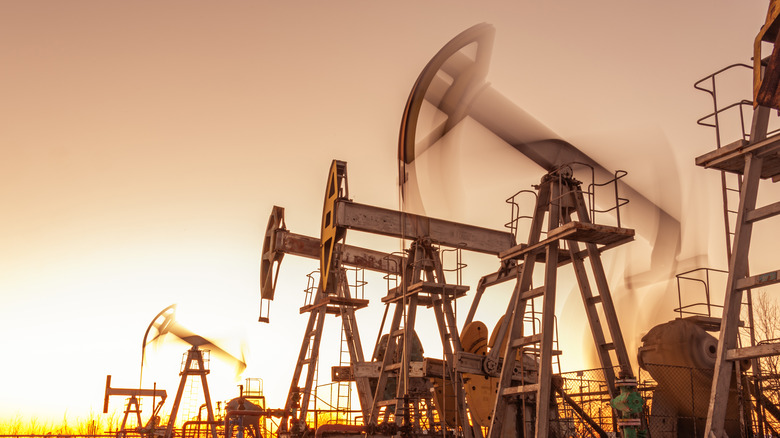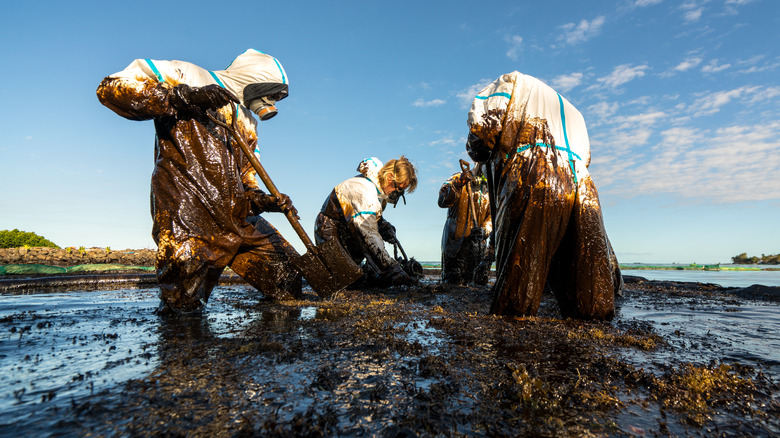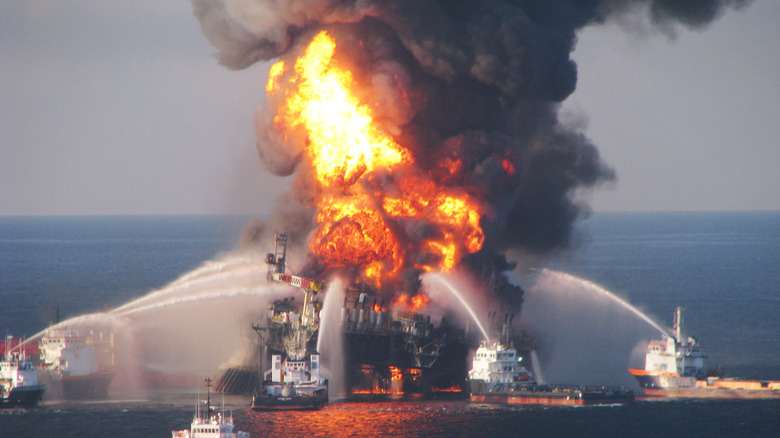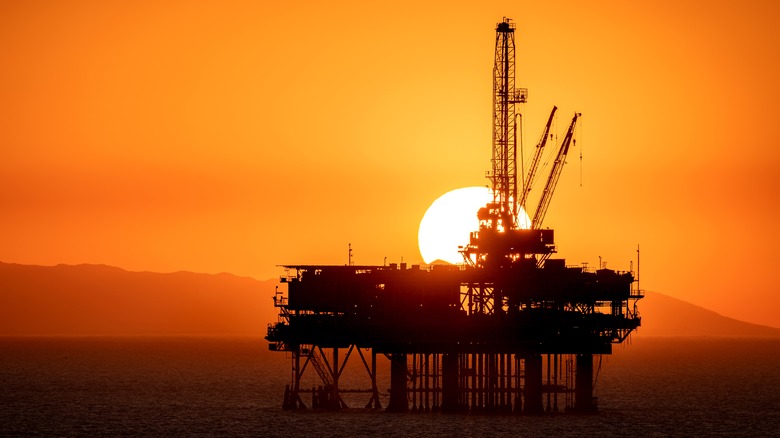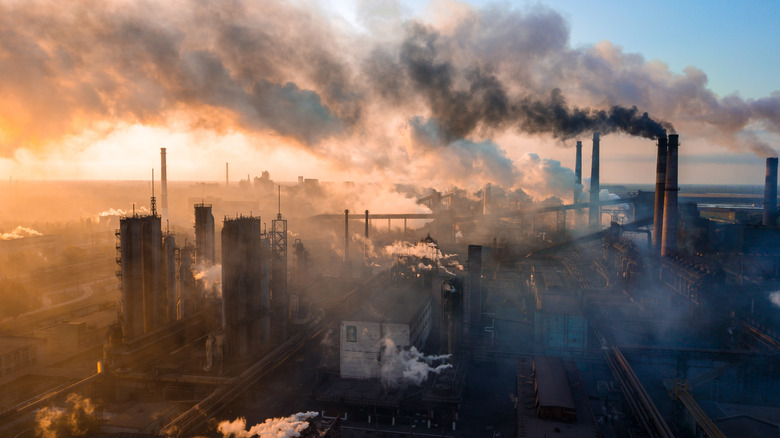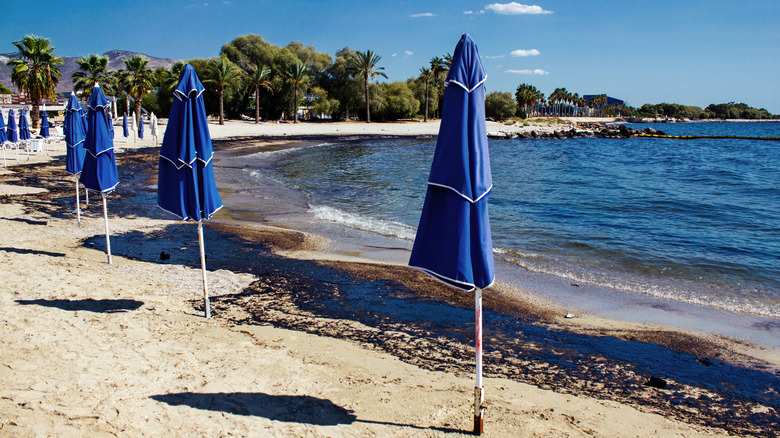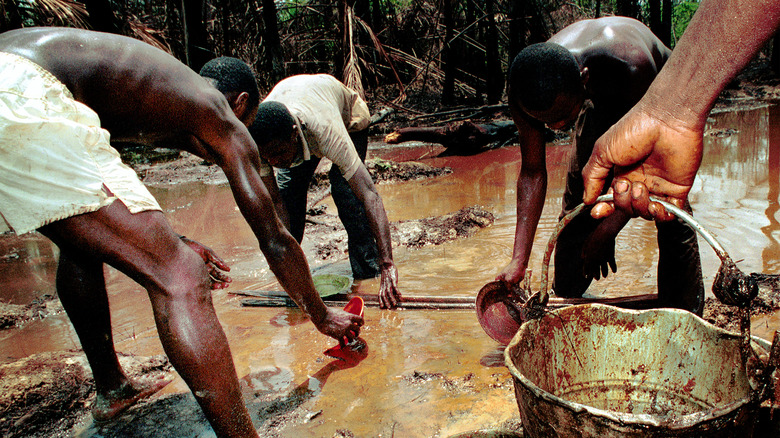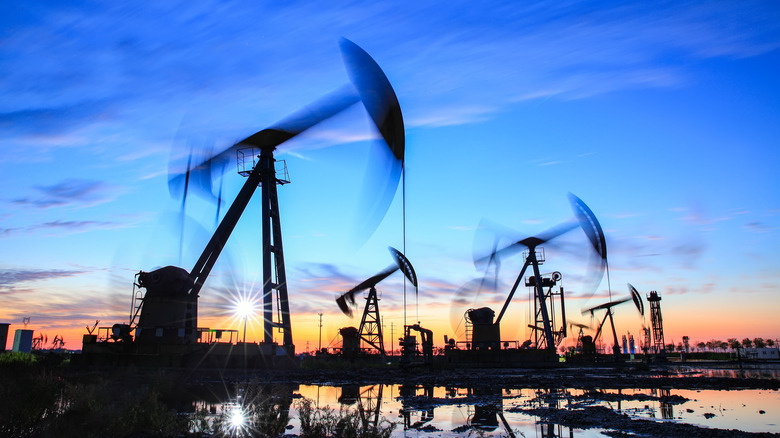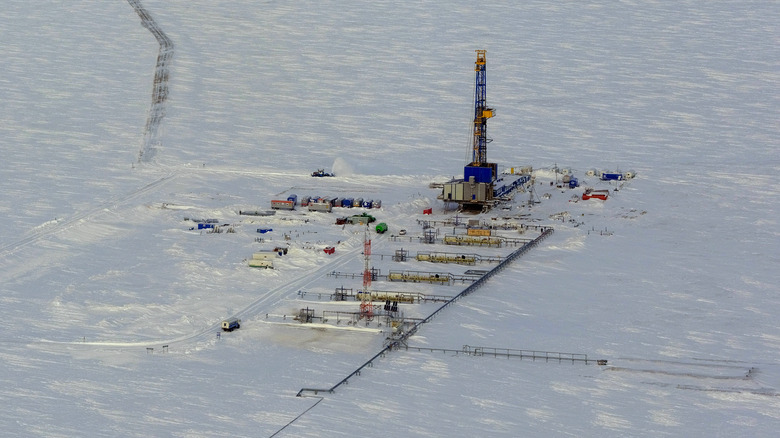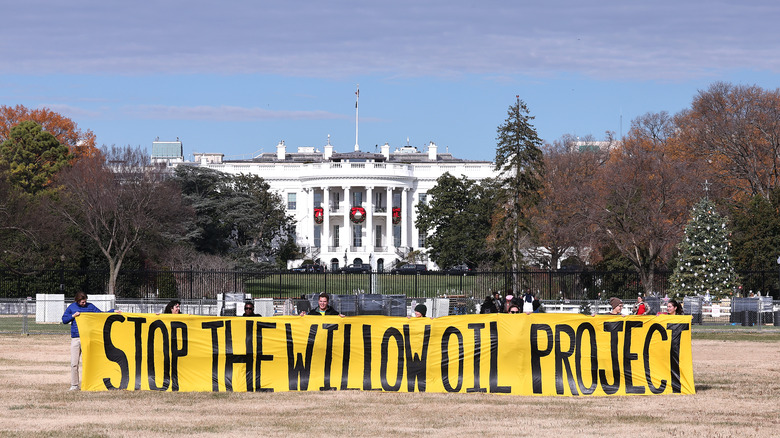The Dark Side Of Oil Drilling And Why It's So Controversial
Oil drilling is a really messy topic — that's been true for a pretty long time. Arguments have flown back and forth wherever a platform for discussing the topic exists, and those debates have never ceased. Nonetheless, oil drilling projects haven't become any less controversial over the years, and neither side of the conversation is willing to back down. Environmental effects versus job creation and industry — at best, it feels like navigating this topic is about as easy as walking through an active minefield.
While it's true that the debate on oil drilling never truly went away, it's managed to rise up and take the spotlight again in early 2023. As for why? Well, that has a whole lot to do with something called the Willow Project — a massive endeavor to start drilling for oil in Alaska. The unknown future of the project has brought the dark side of oil drilling to the forefront of everyone's mind once more, and it's stirred up other controversies besides that.
All that said, if you're not completely caught up on the negatives of oil drilling, here's a bit of a primer for you. It's not a pretty sight, to put it lightly.
Massive oil spills
In many ways, this one feels like it goes without saying. After all, it's hard not to be familiar with the photos taken at oil spills: black, sticky liquid coating shorelines and clinging to local wildlife. But for all that the photos say, they don't quite paint the full picture.
In the short term, there are all the immediate effects on local animal populations, as laid out by the Oiled Wildlife Care Network. The oil messes with the structure of feathers and furs; among other effects, many animals lose the ability to trap their own body heat and keep warm. Then there are the effects of ingesting or inhaling the oil and its fumes, and, well, crude oil wasn't meant to be inside living beings. Unsurprisingly, the damage to affected animals' internal organs is extensive.
And that's not all, because research has begun turning to the long-term effects, explained by an article published in Environmental Science & Technology. For one, spilled oil doesn't just disappear. In the case of the Exxon Valdez spill from 1989, which had fairly minimal cleanup, oil could be found on the surface 12 years later; by 2015, those deposits were still there, only moving a bit underground. Even in cases where there was extensive cleanup, as with the Hebei Spirit spill of 2007, oil still persisted just under the surface for years. And animal populations? They often saw declining birth rates and greater mortality rates, with recovery sometimes expected to take decades (if expected at all).
Catastrophic failures
It's hard to discuss the negatives of oil drilling without looking at the disasters. There have been many, many oil spills, but there have also been dramatic failures of oil rigs — ones that involved deaths.
On that front, the Deepwater Horizon spill of 2010 is a prime example, starting off with an explosion. The rig, located in the Gulf of Mexico, saw a seemingly spontaneous bubble of natural gas rise upward, easily blasting its way through the core and containment structures. Then, given this is an industrial facility and natural gas is volatile, to say the least, the bubble did what you would expect given the situation: It exploded, killing 11 and injuring 17 others. And then, just to make matters worse, it was revealed that Transocean and BP (the operator and owner of the rig, respectively) had ignored signs that catastrophic failure was on the horizon.
Deepwater Horizon isn't a one-time example of things going horrifically wrong, though. According to Arnold & Itkin, the number of oil rig disasters between 1969 and 2015 is extensive. 1982 saw the sinking of the Ocean Ranger drilling rig, in which harsh weather conditions led to the loss of all 84 people aboard. 1980 is considered to be the year of the deadliest oil rig accident: Structural portions of the Alexander L. Kielland spontaneously broke, and 123 people died as the platform sank. And 2015 by itself played host to three different disasters — two explosions and a fire — killing nearly 20 people in total.
Oil rig installation and normal operations harm local ecosystems
When you think about pollution from oil drilling rigs, the first things that may come to mind are the effects of an oil spill. And that makes sense, given the devastating ecological effect of those spills, but the story doesn't stop there.
When it comes to deep-water oil rigs, according to an article in Frontiers in Environmental Science, pollution and ecological disruption starts before a rig is even installed. Surveying equipment is sent down into the water to map the area, but that process is basically accomplished by pumping the ecosystem full of unnatural light and sound that can be detected thousands of miles away. The effect of those lights hasn't been fully explored, but the article acknowledges that there may be negative impacts. As for the sound? Reports have said that marine life is harmed by these surveillance methods, which have completely interrupted their ability to communicate, and even caused physical harm in some cases. All that aside from, you know, the expected stress that comes from humans showing up and blasting loud noises in their home.
And then there's installation to consider, which involves pressing heavy anchors into the ground, a process that permanently scars the sea bed and inflicts sometimes-irreparable damage to fragile ecosystems like coral reefs. Not only that, but liquid waste — a mix of water and oil — starts flowing at that point, and then it continues to leak into the ocean for the entire lifetime of the rig.
Detrimental effects on human health
As an article published in the journal Science of The Total Environment says, there are more and more people worldwide who have to live in the vicinity of active oil drilling rigs. In the U.S. alone, there are eight million people living in relative proximity to oil rigs of one kind or another, so looking at the health risks associated with those living conditions is a pretty important thing to do. Especially because it's really quite scary.
When you look at the effects of oil extraction worldwide, you find a long laundry list of medical conditions, and the statistics that accompany them are concerning. Typically, instances of all different types of cancer skyrocket in communities around active oil rigs; childhood cancer in particular has been studied multiple times, with reports saying that there's definitely a correlation between it and nearby oil operations. But cancer isn't the only problem, with other studies indicating that those same types of rigs also seemed to have a hand in causing respiratory, cardiovascular, and neurological problems, among a whole host of other medical anomalies of organs like the thyroid and liver. That's not even counting greater rates of self-reported symptoms such as headache and dizziness.
And when it comes to the people who work on those rigs? Exposure to high levels of hydrocarbons was linked to an increased risk of DNA damage, while hydrogen sulfide gas could cause an array of symptoms, from nose bleeds to significant neurological damage.
Adverse economic effects
As outlined by ITOPF, in the event of an oil spill local economies and businesses suffer in massive ways. After all, especially when it comes to spills from offshore drilling rigs, all of that oil washes up into coastal communities — areas that can typically benefit greatly from the tourism industry. And when your tourist attraction is covered in muddy crude oil, no one is rushing to book a flight and hotel there. Things don't even necessarily improve once cleanup efforts are finished; tourists don't just forget that an oil spill happened, and that perception can affect their choice in vacation spots for years to come. Fishing is also hurt for obvious reasons, but so is any business that relies on seawater — local docks, and even heavy industrial facilities can be affected.
Even if you look to smaller communities that don't exactly profit from tourism or big business, oil spills hurt them, too. As The Guardian explains, the oil spills in Nigeria have turned once-vibrant villages into shallow husks — veritable ghost towns. Everyone had to move away, because how do you continue your livelihood when everything is slick with oil?
But if you want to argue that this is only a problem in the case of oil spills, here's the thing: It's not. A study by SELC showed that, in the Gulf of Mexico, public perception seems to go a really long way, as tourist spots with nearby rigs made about half the income of tourist spots without those rigs. Now that's a pretty marked difference.
Harming the social and cultural landscape of local communities
When it comes to the negatives of oil drilling, there are the concrete things to consider — pollution, money, safety, and so on — but there's also the social aspect to take into account. After all, people aren't robots; psychology isn't something to just be ignored.
The Office of Response and Restoration published an article discussing the social impacts that an oil spill can have, finding that, simply put, it stressed everybody out. People who lived around the Exxon Valdez oil spill began feeling like they just didn't have control, yet at the same time, they were being bombarded with the attention of the rest of the world. But all the while, the community itself was splitting at the seams from the increased tension. By the end of it, everyone just wanted it to stop.
But the advent of an oil spill is really just an amplification of problems that oil drilling can bring to a community. An article published in Frontiers in Public Health examined the social effects of drilling in countries like Sudan and Nigeria, noting something called "social exclusion" — essentially the situation where local people aren't given a say in country-wide decisions, nor gain anything from them. The effects are wide-reaching, but include things like perpetuating poverty, eliminating opportunities for community members to bond, and destroying lands important to local people (thus making it hard or impossible to continue long-time cultural traditions). And all of that is happening in the background, largely unnoticed.
Corruption, negligence, and skirting liability
The physical damages caused by oil drilling and related disasters are terrible and shouldn't be ignored. But here's the thing: There's plenty of behind-the-scenes drama that's just as harmful, but far more insidious.
The oil spills in the Niger Delta encapsulate these terrible problems perfectly. According to The Guardian, Shell had built — then abandoned — oil pipelines in the Niger Delta throughout the mid-20th century. And then they did little to maintain them. So come the 21st century, those pipes started to burst. Millions of gallons of oil polluted towns, forcing people to abandon their homes.
Now, you'd think Shell would be held liable, right? Well, the Nigerian government had already shown its corruption by hanging environmental activists in the 1990s, and now it was Shell's turn to skirt liability. They liked to claim that this wasn't a problem of negligence, but rather sabotage — an explanation that would absolve them of guilt. In some cases, they outright lied in public reports about how much oil had spilled; doing so allowed them to hand out compensation that was insultingly low, sometimes only a couple thousand dollars in total (via Amnesty International). And when they were forced into court, they stalled by lying about the existence of maintenance reports, only to hand over redacted documents that could prove nothing once their lie was exposed. The legal battle lasted for over a decade, and though Shell's local subsidiary was finally held liable, the corruption and shady methods don't paint a good picture.
Is it even worth it?
When it comes to the debate of domestic oil drilling, you typically see some very specific arguments in its favor: weaning the U.S. off of dependence on foreign sources of oil, and the creation of more jobs to boost the economy. The latter has a leg to stand on, but the former is more flawed than it may initially seem.
The basis of that argument tends to follow a specific direction regarding rising gas prices, or the whims of international political issues that could disrupt the supply of oil. Essentially, producing more oil domestically would lower prices because it doesn't have to be imported, and supply could be more reliable. Energy independence, right? But according to the Center for American Progress, it's a pointless discussion. Even if more oil rigs were approved, that wouldn't immediately change gas prices. It takes years for a rig to be built and begin producing oil — years where no one benefits. And by the time the rig is ready to work? There's no telling what the global market could look like, so there might not even be a need to increase domestic drilling. But let's say gas prices are still a problem. Well, the volume of oil from one or two rigs is nowhere near enough to actually cover America's energy needs anyway.
Oil drilling is nothing more than a temporary solution, and building more rigs may only continue to tie the U.S. to dependence on fossil fuels, perpetuating the same problems it claims to solve.
What's the Willow Project?
Oil drilling has been a controversial topic for a long time and for a lot of reasons, but just what is this Willow Project that's suddenly got everyone up in arms? Well, according to ConocoPhillips, the company behind the Willow Project, it's a massive undertaking, and one that's technically been in development for over two decades. The scope of their project originally included either four or five different drill sites in a massive area of undeveloped public land, and they claim it will bring massive boons: up to $17 billion in revenue, 2,300 jobs (300 of which are permanent), and over 600 million barrels of oil over its entire lifetime.
That's basically the elevator pitch — economic growth, more resources, all that — and as the company itself said, it's been in development for quite a while. In fact, it was publicly announced back in 2017, and Alaska Public Media adds a bit more on that front. See, the project had initially been approved by the Trump administration, and ConocoPhillips continued working on it until 2021. At that point, however, a federal judge stepped in and reversed that decision (which, up to that point, had actually been supported by the Biden administration). Judge Sharon Gleason ruled that approval had been given based on unsubstantiated assumptions about the actual environmental effect this project could have, and development on it was effectively halted.
What's happened since 2021?
In 2021, the Willow Project was halted, but it wasn't killed. Far from it. According to Reuters, the overall plan for the Willow Project started getting workshopped and, ultimately, scaled back. Instead of five drills, it would only include three, and these compromises led the Biden administration to say they would consider giving the project their support back in February 2023. But with a final decision looming on the horizon, the topic erupted on social media, and activists raised their voices against it, with millions writing letters and signing online petitions in protest (via CNN).
The Protect Our Winters organization has also given further input, highlighting exactly what the backlash to the Willow Project encompasses. For one, they argue that dropping a huge oil rig down in the middle of the Alaskan wilderness ruins the land that plenty of people have spent years trying hard to protect. What's more, they point to numbers that would imply the Willow Project will have a far greater environmental impact than anyone should be willing to accept: 250 million metric tons of carbon dioxide that are going to get pumped into the air, only worsening the existing climate change problem over the next 30 years.
